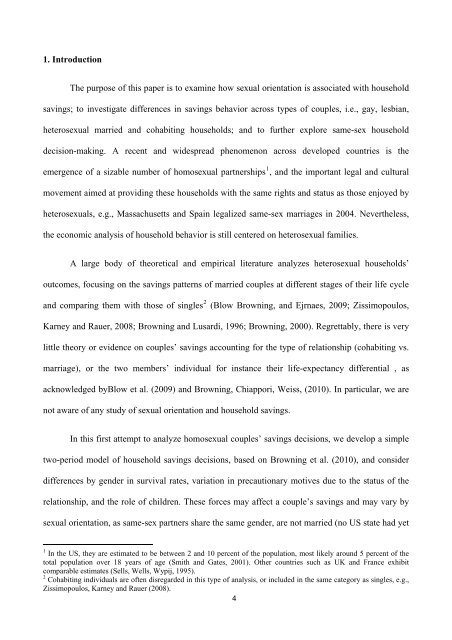Download PDF - Ivie
You also want an ePaper? Increase the reach of your titles
YUMPU automatically turns print PDFs into web optimized ePapers that Google loves.
1. Introduction<br />
The purpose of this paper is to examine how sexual orientation is associated with household<br />
savings; to investigate differences in savings behavior across types of couples, i.e., gay, lesbian,<br />
heterosexual married and cohabiting households; and to further explore same-sex household<br />
decision-making. A recent and widespread phenomenon across developed countries is the<br />
emergence of a sizable number of homosexual partnerships 1 , and the important legal and cultural<br />
movement aimed at providing these households with the same rights and status as those enjoyed by<br />
heterosexuals, e.g., Massachusetts and Spain legalized same-sex marriages in 2004. Nevertheless,<br />
the economic analysis of household behavior is still centered on heterosexual families.<br />
A large body of theoretical and empirical literature analyzes heterosexual households’<br />
outcomes, focusing on the savings patterns of married couples at different stages of their life cycle<br />
and comparing them with those of singles 2 (Blow Browning, and Ejrnaes, 2009; Zissimopoulos,<br />
Karney and Rauer, 2008; Browning and Lusardi, 1996; Browning, 2000). Regrettably, there is very<br />
little theory or evidence on couples’ savings accounting for the type of relationship (cohabiting vs.<br />
marriage), or the two members’ individual for instance their life-expectancy differential , as<br />
acknowledged byBlow et al. (2009) and Browning, Chiappori, Weiss, (2010). In particular, we are<br />
not aware of any study of sexual orientation and household savings.<br />
In this first attempt to analyze homosexual couples’ savings decisions, we develop a simple<br />
two-period model of household savings decisions, based on Browning et al. (2010), and consider<br />
differences by gender in survival rates, variation in precautionary motives due to the status of the<br />
relationship, and the role of children. These forces may affect a couple’s savings and may vary by<br />
sexual orientation, as same-sex partners share the same gender, are not married (no US state had yet<br />
1 In the US, they are estimated to be between 2 and 10 percent of the population, most likely around 5 percent of the<br />
total population over 18 years of age (Smith and Gates, 2001). Other countries such as UK and France exhibit<br />
comparable estimates (Sells, Wells, Wypij, 1995).<br />
2 Cohabiting individuals are often disregarded in this type of analysis, or included in the same category as singles, e.g.,<br />
Zissimopoulos, Karney and Rauer (2008).<br />
1

















